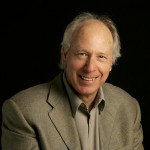Here is a link to my Tuesday column about Caitlyn Jenner. The full text runs below:
Bruce Jenner stood there unable to speak. Unable to explain.
It was 1975, a year before Bruce won the Olympic decathlon in Montreal, but track fans already knew he was the best decathlete in the world, the best athlete on the planet. I was interviewing Bruce in his tiny apartment in San Jose overlooking the track at San Jose City College. Bruce could have jumped out the window, landed on the track and started his workout.
I would ask questions and Bruce would answer — he was polite and so was his wife Chrystie who served us tea. But his answers were vague and shallow and dull, and I feared I had a dead interview on my hands. Searching for something — anything — to bring him out, I stared at the wall over the couch and saw a poster. As I recall it was Roger Bannister crossing the finish line as he broke four minutes in the mile — he was the first to run a sub-four-minute mile. On the poster were some words I can’t remember.
“Why did you put that poster on the wall?” I asked.
“Because it’s my creed,” Bruce said.
This was something live, a window into Bruce’s personality. I asked him to stand in front of the poster and explain its meaning to him. He got up from the table and walked over to the poster. He was wearing shorts and a t-shirt, had the body of a god. He tried to speak but no words came out. He stood in front of that poster a long time while Chrystie and I grew uncomfortable.
“I can’t do it,” he finally said.
To me, this was amazing. Bruce couldn’t explain his own creed. At the time, I thought he was a world-class athlete and a world-class dope, a jock who thought of nothing but his sport. I don’t think that anymore. I have watched Caitlyn Jenner’s interview with Diane Sawyer and she comes across intelligent, thoughtful, deep. She is the exact opposite of the Bruce I met 40 years ago. Her whole life she’s had lots to think about, like, “Who am I?”
I believe — I am sure — when I asked Bruce to explain his creed, in a sense to explain the meaning of his life, he didn’t stand a chance. It was the one thing he could not put into words, this paradox — his paradox. He had the body of a man but the soul of a woman. He was searching and questioning and mentally flailing. And probably failing. That’s what his dead silence in front of that poster meant. He didn’t have the right words for me. For himself.
If you want to be metaphorical about it, the poster of Bannister running was a perfect picture of Bruce. He was running away from himself. Or running toward himself. He was running.
I have thought about Bruce since then. Thought about him a lot. Please understand, I am making a distinction between Bruce and Caitlyn to keep the chronology of this article orderly. I don’t know if Caitlyn makes the same distinction. I knew him as Bruce. Now I think of her as Caitlyn. I admire what she has done, but I keep reading and hearing criticism of her. It goes something like this.
The image of woman she has chosen for herself is the wrong image. It is a harmful image. A vain image. Caitlyn is gorgeous in the 1950s va-va-va-boom bombshell sense. Jayne Mansfield meets Kim Novak. The ordinary woman, I have read, cannot compete with that unreal Hollywood image and that disparity between image and reality is the problem.
Elinor Burkett wrote an op-ed piece in the New York Times criticizing Caitlyn. Burkett went after Caitlyn for her photo on the cover of Vanity Fair. “(The cover) offered us a glimpse into Caitlyn Jenner’s idea of a woman,” Burkett wrote, “a cleavage-boosting corset, sultry poses, thick mascara and the prospect of regular ‘girls’ nights’ of banter about hair and makeup.”
Burkett angrily added, “I have fought for many of my 68 years against efforts to put women — our brains, our hearts, our bodies, even our moods — into tidy boxes, to reduce us to hoary stereotypes.”
I take Burkett seriously, although the word “hoary” is either insensitive or a clever pun on her part. Something about Caitlyn offends Burkett, undercuts her idea of a woman. But I say to Burkett — have a heart. I wish Burkett could have seen Bruce dumbstruck before that poster four decades ago.
I also say this. The women’s movement, as far as I understand it, says women can be whoever they want to be. Don’t have to fit a stereotype. They can be corporate executives, editors of newspapers (the executive editor of The Press Democrat is Catherine Barnett), and champions in Ultimate Fighting like Ronda Rousey. The world is — or should be — as open to women as men.
But a woman also can choose to be a housewife. No shame in that. None at all. That’s the free-choice part. And if she wants, a woman can choose to wear makeup and project a glamorous look to please herself. Why not?
For her whole life, Caitlyn lived up to others’ idea of who she should be. The effort took her words away. Now she’s saying she wants to be a particular kind of woman, at least in public, a style that makes her happy. Is it surprising she’d choose a look wholly different than what she was?
Caitlyn can be any kind of woman she wants. That’s the whole point.
For more on the world of sports in general and the Bay Area in particular, go to the Cohn Zohn at cohn.blogs.pressdemocrat.com. You can reach Staff Columnist Lowell Cohn at lowell.cohn@pressdemocrat.com.

